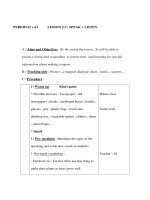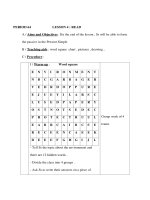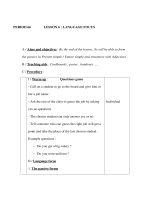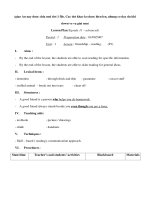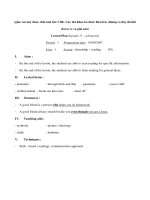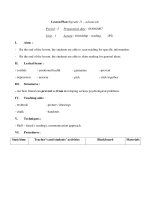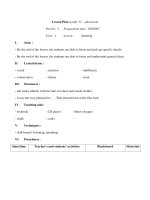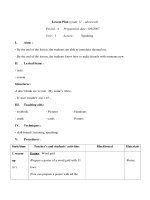Giáo án Anh văn lớp 11 - Unit 10 - Period 83 pptx
Bạn đang xem bản rút gọn của tài liệu. Xem và tải ngay bản đầy đủ của tài liệu tại đây (20.09 KB, 5 trang )
Lesson Plan (grade 11 – advanced)
Period : 83 Preparation date :28 /1/2008
Unit : 10 Lesson : Speaking
I. Aims :
- By the end of the lesson, the students are able to use alternative ways to say things.
- By the end of the lesson, the students are able to ask for or give clarification.
II. Lexical items :
- exploit - smelly
III- Structures :
- let me put it another way.
- what exactly do you mean?
IV- Teaching aids:
- textbook - Handouts
- chalk - cards
V- Techniques :
- skill-based ( listening, speaking)
VI- Procedures :
State/time Teacher’s and students’ activities Blackboard Materials
1. warm-up
(7’)
Games: ‘Banana’
- draw a square of 9 numbered boxes.
(appendix)
- ask SS to work in two groups,
Monkey and Mickey.
- Tell SS that in each box is a
-chalk
and board
description of a ‘banana’ , and there
are two bananas in the boxes 2 and 7.
- tell the groups to take turns to choose
a number, and listen to the description
and name the ‘banana” in the box. If
they get it right, they win one point. If
they can’t get it right, the other group
have the chance to answer and score
points. If it is a banana, they score one
point without answering any
questions.
- the group that has more points will
win the game.
- check SS’ understanding of
instructions.
- have SS start the game.
- keep a running total of points for
each group on the board.
- declare the winner.
Transition:
Today we will talk about the
advantanges and disadvantages of
different sources of energy, focusing
on the language used to ask for and
P 83: Unit 10 : speaking
make clarification.
-Write down on the board :
2. Pre-
Speaking
(7’)
* eliciting and introducing Useful
language
- elicit from SS questions for
clarifaction when they don’t
understand something
- elicit the structures used to give
explanations or clarification for
something.
- read the example exchange and
explain the situation for SS to see how
the phrases are used.
Useful language:
* asking people to
clarify:
- sorry, I don’t quite
understand.
- what exactly do you
mean?
- what does that mean?
* saying sth in another
way.
- I mean ……. / that
means
- what I mean is …
Chalk and
board
Textbook
3. while-
Speaking.
(20’)
Activity 1: Advantages and
disadvantages – Information Gap (
task b, p. 145)
- pair off SS as A and B
- deliver cards A to students A, and
cards B to students B ( appendix 2)
- ask SS to work in pairs , talking
about the advantages and
disadvantages of the sources of
Textbook
cads
energy. SS with a gap in the
explanation will ask for clarification,
and SS with full information will make
clarification.
- model an example exchange with a
student and then have SS so the task.
- go around to monitor and note down
errors if any for correction late.
- call on some close and open pairs to
act out their conversations in front of
the class.
Activity 2: personalization (task c,
p.145)
- ask SS to work in pairs, talking about
the advantages and disadvantages of
the cooking fuels and transportation
fuels currently used in their home or
neighborhood.
- act out the example exchange with a
student as a model.
- have SS start the activity.
- go around to monitor and give help
with vocabulary or ideals if necessary.
- call on some pairs to act out their
textbooks
4. Post-
Speaking
(10’)
5.Homework(1’)
conversations and invite SS to give
comments
- give feedback and comments.
Listening:
-read out mixed expressions of how to
do something
- SS listen and write down
Sentence Making
- Ask Sts to make a few sentences
about giving instructions
